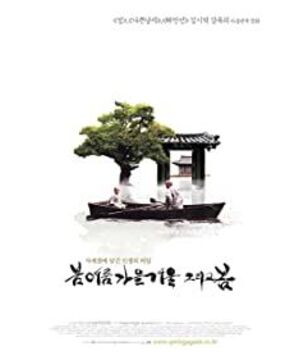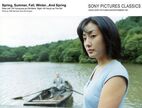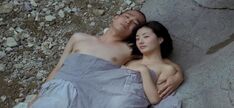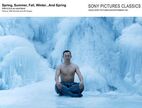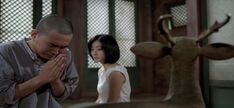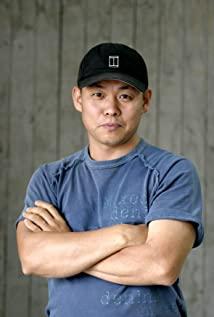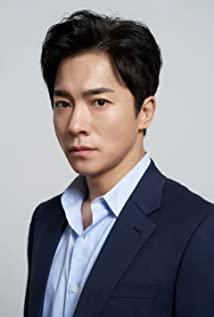This movie with the temple as the background integrates the cycle of life into the four seasons of spring, summer, autumn and winter, and also expresses pain, trouble, love, and worldliness through the change of seasons.
The spring of sin and redemption.
In the middle of the lake surrounded by mountains, there are wooden huts where old monks and young monks live.
The little monk playfully tied the fish, frogs, and snakes to stones, watching the small animals struggle in pain, twisting their bodies to reveal their white teeth missing their front teeth and laughing. You can't imagine this being a child's joy extended from sin itself.
The old monk stood here and watched silently.
The next day, he also tied a stone on the back of the little monk to let him experience the hardship and ordered him to release the small animals.
The summer of desire and indulgence.
Years later, the little monk had grown up and turned into a teenager. He couldn't turn his eyes away from the snakes entangled in the rocks.
A young girl who was recovering from illness came to the temple. The monk fell in love with the girl, and the girl did not refuse.
The two secretly dated together, he asked her if it still hurts? She said it doesn't hurt.
After the incident was revealed, the master asked him if it still hurts? He said it doesn't hurt.
This medicine is right, and the disease is cured, so I leave.
Autumn of love and hate.
The young monk who once refused to leave for the sake of the girl is now a young man, and his deep and domineering love has made him a murderer.
When he returned to the temple with pain and torture, the old monk explained to him that this is the inevitable truth of cause and effect.
Unable to bear the uneasiness and the heavy pressure, the monk who was determined to commit suicide was strongly urged by the master.
It is easy to kill others, but difficult to kill yourself.
The police came, and the master ordered him to write with peace of mind. After the writing was finished, the knot in the monk's heart was also untied.
He followed the police away, but at this time the old monk set himself on fire.
The Winter of Philosophy and Reflection.
Years later, the young monk was already a middle-aged man. He was released after serving his sentence and returned to the temple to devote himself to Buddhism. The hard ice in winter can't make people feel the cold.
A masked woman came to the temple and put down the baby.
At this time, the monk tied a stone behind his back and waded through the mountains and rivers, with all his heart to the Buddha.
Another spring...
endlessly, endlessly.
From childhood to youth to youth to middle-aged to old age, the little monk Jin Ji-de tells the story with delicate and pure pictures. Even if it is a movie related to such a profound theme as what is the meaning of life, it is quiet and peaceful everywhere.
This beautiful picture is spread out in front of us for us to savor and ponder slowly.
Undoubtedly, Buddhist thought occupies an important position in this film. Is human nature inherently good or human nature inherently evil? Kim Ki-duk gives you the answer. In such a reincarnation, only practice can redeem oneself and save the soul.
View more about Spring, Summer, Fall, Winter... and Spring reviews


